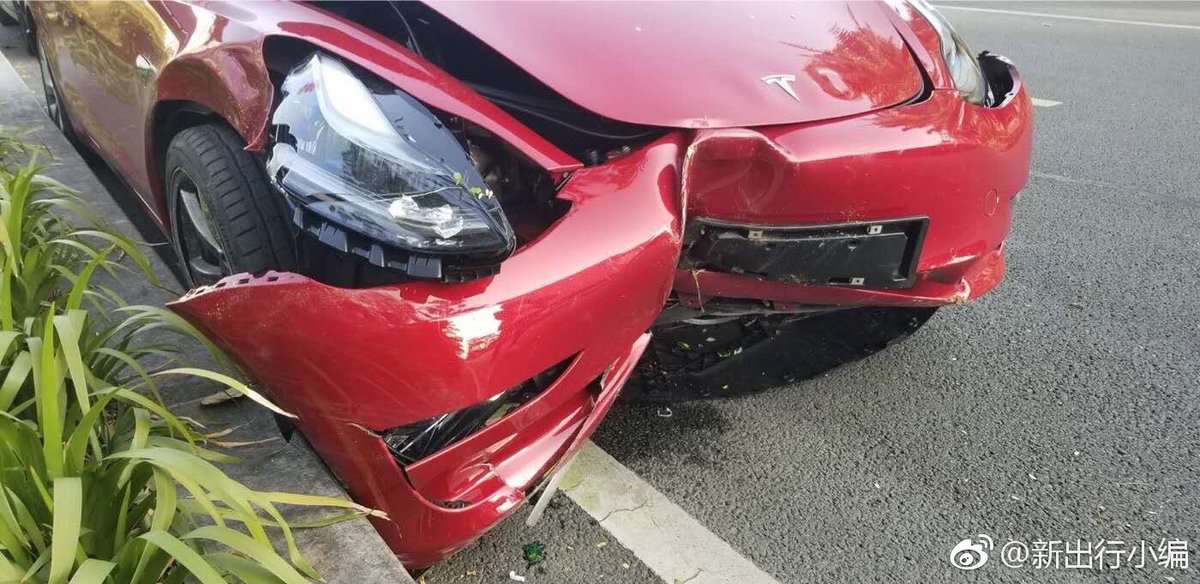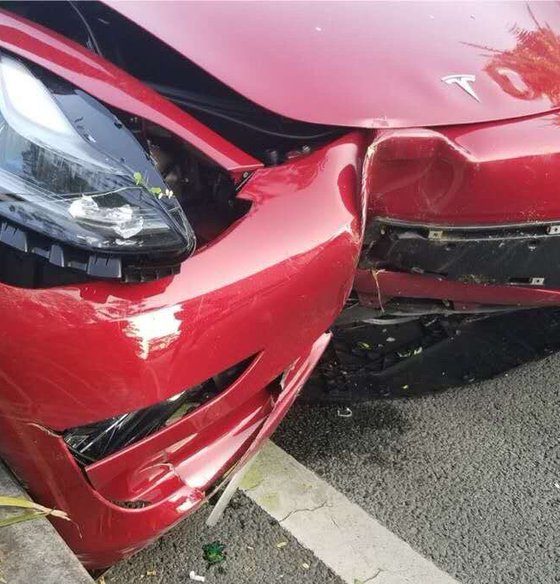

News
Tesla Model 3 test drives in Shenzhen paused after customer crashes first unit
Tesla set out to remove the perception that electric cars are slow, boring vehicles which are no more special than glorified golf carts. The company accomplished their goal with the original Tesla Roadster, the Model S, Model X, and now, the Model 3. While Tesla’s electric cars are proven to be quick on their feet, there is one particular fact that usually gets overlooked — it takes a responsible and proficient driver to handle the power provided by the company’s vehicles.
This point was highlighted recently in Shenzen, China. Tesla is expected to begin deliveries of the Model 3 in the Asian country, and to help prepare reservation holders and potential customers for the sedan’s arrival; the electric car maker has started a test drive program for the vehicle. Just as planned by Elon Musk for the United States, the test drive units that were initially sent to China were Model 3 Performance, the top tier variant of the electric sedan that is known for being very quick, whether in straight-line acceleration or around a track. Unfortunately, one test driver in Shenzen, China proved to be unprepared for the power of the Model 3 Performance.
As shared by Tesla owner-enthusiast JayinShanghai on Twitter, the Model 3 test driver ended up crashing the electric sedan. An image of the vehicle, as well as a short clip of the electric car after the accident, showed the extensive damage to the front of the car. While Tesla has not revealed the specifics of the incident, the damage incurred by the Model 3 Performance suggests that the vehicle might have crashed into a pole.
First Tesla Model 3 Performance Crash in China. Test Drive Car in Shenzhen, 3.5 second (0-100Km/h) isn’t for everyone. Photo credit to 新出行小编 via Weibo #Tesla #TeslaChina #Model3Performance #TeslaCrash #特斯拉 pic.twitter.com/K6NsT4QiIv
— Jay in Shanghai 电动 Jay 🇨🇳 (@JayinShanghai) February 7, 2019
Due to the crash, Model 3 test drives in Shenzen were promptly stopped, at least until another test unit could be shipped to the area. Fortunately, the wait for another Model 3 test drive car was short. As shared by Tesla enthusiast Kelvin Yang on Twitter, reports have emerged stating that another Model 3 Performance has been shipped to Shenzen as a replacement for the crashed test drive unit. Unlike the red sedan that was damaged from the incident, Shenzen’s new Model 3 Performance test drive car is painted black and equipped with 19″ Power Sports Wheels.
Seemingly without missing a beat, Tesla has reportedly started taking appointments for test drives in the new vehicle. In a later update, Yang noted that the new Model 3 test drive car is already fully booked, with interested customers being required to wait an average of more than two hours for their turn.
New test drive vehicle arrived pic.twitter.com/o3ajG7FXDh
— Kelvin Yang (@KelvinYang7) February 8, 2019
Tesla’s rapid response to its damaged Model 3 test drive unit in Shenzen is impressive. Considering that deliveries in the country are yet to begin, the company showed a considerable amount of proficiency with its logistics by shipping another test drive unit to the city immediately following the first vehicle’s crash. This, if any, bodes well for the upcoming Model 3 deliveries in the region.
Unlike the Tesla Model S P100D and the Model X P100D, the Model 3 Performance is not equipped with a dedicated feature that optimizes it for straight-line acceleration. Instead, the Model 3’s top variant utilizes the raw power of its dual electric motors, which produce a combined 450 hp and 471 lb-ft of torque. The Model 3 Performance lives up to its moniker, with its 0-60 mph time of 3.3 seconds, its top speed of 155 mph, and its range of 310 miles per charge. The car is also equipped with a Track Mode feature, which optimizes the vehicle for intensive driving around a racetrack.
Watch the aftermath of Shenzen’s Model 3 Performance test drive unit’s crash in the video below.
Model 3 test car crashed and all test drive in Shenzhen got cancelled /facepalm. Video from local WeChat group pic.twitter.com/n3ifTpkVpV
— Kelvin Yang (@KelvinYang7) February 7, 2019

Elon Musk
Elon Musk’s X will start using a Tesla-like software update strategy
The initiative seems designed to accelerate updates to the social media platform, while maintaining maximum transparency.

Elon Musk’s social media platform X will adopt a Tesla-esque approach to software updates for its algorithm.
The initiative seems designed to accelerate updates to the social media platform, while maintaining maximum transparency.
X’s updates to its updates
As per Musk in a post on X, the social media company will be making a new algorithm to determine what organic and advertising posts are recommended to users. These updates would then be repeated every four weeks.
“We will make the new 𝕏 algorithm, including all code used to determine what organic and advertising posts are recommended to users, open source in 7 days. This will be repeated every 4 weeks, with comprehensive developer notes, to help you understand what changed,” Musk wrote in his post.
The initiative somewhat mirrors Tesla’s over-the-air update model, where vehicle software is regularly refined and pushed to users with detailed release notes. This should allow users to better understand the details of X’s every update and foster a healthy feedback loop for the social media platform.
xAI and X
X, formerly Twitter, has been acquired by Elon Musk’s artificial intelligence startup, xAI last year. Since then, xAI has seen a rapid rise in valuation. Following the company’s the company’s upsized $20 billion Series E funding round, estimates now suggest that xAI is worth tens about $230 to $235 billion. That’s several times larger than Tesla when Elon Musk received his controversial 2018 CEO Performance Award.
As per xAI, the Series E funding round attracted a diverse group of investors, including Valor Equity Partners, Stepstone Group, Fidelity Management & Research Company, Qatar Investment Authority, MGX, and Baron Capital Group, among others. Strategic partners NVIDIA and Cisco Investments also continued support for building the world’s largest GPU clusters.
News
Tesla FSD Supervised wins MotorTrend’s Best Driver Assistance Award
The decision marks a notable reversal for the publication from prior years, with judges citing major real-world improvements that pushed Tesla’s latest FSD software ahead of every competing ADAS system.

Tesla’s Full Self-Driving (Supervised) system has been named the best driver-assistance technology on the market, earning top honors at the 2026 MotorTrend Best Tech Awards.
The decision marks a notable reversal for the publication from prior years, with judges citing major real-world improvements that pushed Tesla’s latest FSD software ahead of every competing ADAS system. And it wasn’t even close.
MotorTrend reverses course
MotorTrend awarded Tesla FSD (Supervised) its 2026 Best Tech Driver Assistance title after extensive testing of the latest v14 software. The publication acknowledged that it had previously criticized earlier versions of FSD for erratic behavior and near-miss incidents, ultimately favoring rivals such as GM’s Super Cruise in earlier evaluations.
According to MotorTrend, the newest iteration of FSD resolved many of those shortcomings. Testers said v14 showed far smoother behavior in complex urban scenarios, including unprotected left turns, traffic circles, emergency vehicles, and dense city streets. While the system still requires constant driver supervision, judges concluded that no other advanced driver-assistance system currently matches its breadth of capability.
Unlike rival systems that rely on combinations of cameras, radar, lidar, and mapped highways, Tesla’s FSD operates using a camera-only approach and is capable of driving on city streets, rural roads, and freeways. MotorTrend stated that pure utility, the ability to handle nearly all road types, ultimately separated FSD from competitors like Ford BlueCruise, GM Super Cruise, and BMW’s Highway Assistant.
High cost and high capability
MotorTrend also addressed FSD’s pricing, which remains significantly higher than rival systems. Tesla currently charges $8,000 for a one-time purchase or $99 per month for a subscription, compared with far lower upfront and subscription costs from other automakers. The publication noted that the premium is justified given FSD’s unmatched scope and continuous software evolution.
Safety remained a central focus of the evaluation. While testers reported collision-free operation over thousands of miles, they noted ongoing concerns around FSD’s configurable driving modes, including options that allow aggressive driving and speeds beyond posted limits. MotorTrend emphasized that, like all Level 2 systems, FSD still depends on a fully attentive human driver at all times.
Despite those caveats, the publication concluded that Tesla’s rapid software progress fundamentally reshaped the competitive landscape. For drivers seeking the most capable hands-on driver-assistance system available today, MotorTrend concluded Tesla FSD (Supervised) now stands alone at the top.
News
Elon Musk’s Grokipedia surges to 5.6M articles, almost 79% of English Wikipedia
The explosive growth marks a major milestone for the AI-powered online encyclopedia, which was launched by Elon Musk’s xAI just months ago.

Elon Musk’s Grokipedia has grown to an impressive 5,615,201 articles as of today, closing in on 79% of the English Wikipedia’s current total of 7,119,376 articles.
The explosive growth marks a major milestone for the AI-powered online encyclopedia, which was launched by Elon Musk’s xAI just months ago. Needless to say, it would only be a matter of time before Grokipedia exceeds English Wikipedia in sheer volume.
Grokipedia’s rapid growth
xAI’s vision for Grokipedia emphasizes neutrality, while Grok’s reasoning capabilities allow for fast drafting and fact-checking. When Elon Musk announced the initiative in late September 2025, he noted that Grokipedia would be an improvement to Wikipedia because it would be designed to avoid bias.
At the time, Musk noted that Grokipedia “is a necessary step towards the xAI goal of understanding the Universe.”
Grokipedia was launched in late October, and while xAI was careful to list it only as Version 0.1 at the time, the online encyclopedia immediately earned praise. Wikipedia co-founder Larry Sanger highlighted the project’s innovative approach, noting how it leverages AI to fill knowledge gaps and enable rapid updates. Netizens also observed how Grokipedia tends to present articles in a more objective manner compared to Wikipedia, which is edited by humans.
Elon Musk’s ambitious plans
With 5,615,201 total articles, Grokipedia has now grown to almost 79% of English Wikipedia’s article base. This is incredibly quick, though Grokipedia remains text-only for now. xAI, for its part, has now updated the online encyclopedia’s iteration to v0.2.
Elon Musk has shared bold ideas for Grokipedia, including sending a record of the entire knowledge base to space as part of xAI’s mission to preserve and expand human understanding. At some point, Musk stated that Grokipedia will be renamed to Encyclopedia Galactica, and it will be sent to the cosmos.
“When Grokipedia is good enough (long way to go), we will change the name to Encyclopedia Galactica. It will be an open source distillation of all knowledge, including audio, images and video. Join xAI to help build the sci-fi version of the Library of Alexandria!” Musk wrote, adding in a later post that “Copies will be etched in stone and sent to the Moon, Mars and beyond. This time, it will not be lost.”








